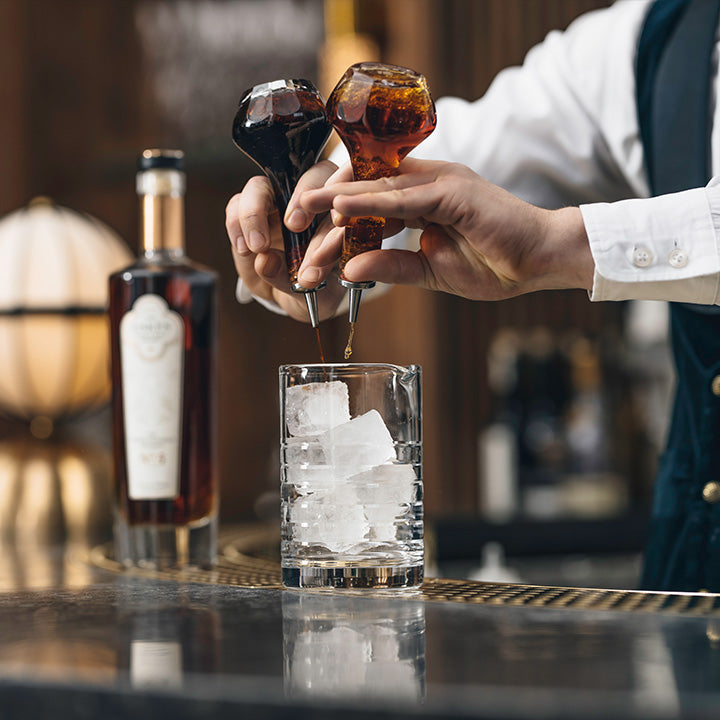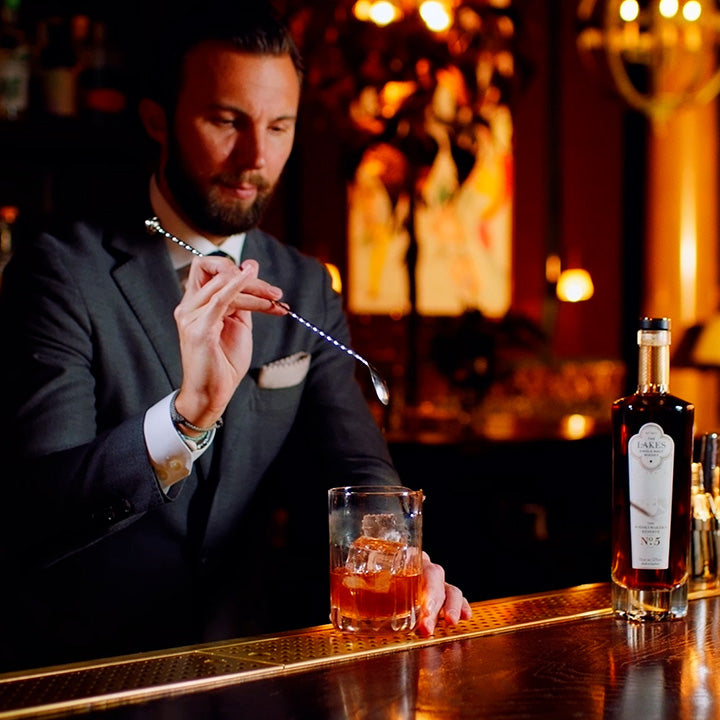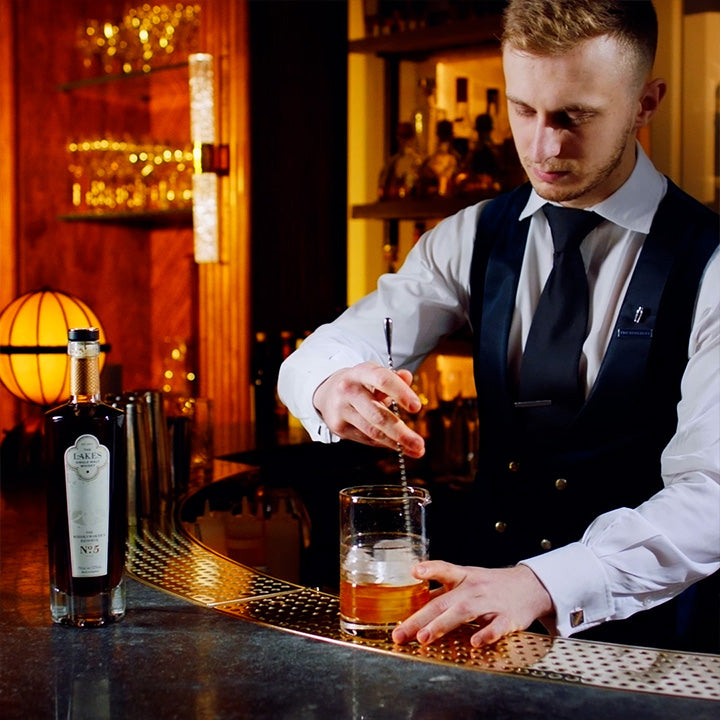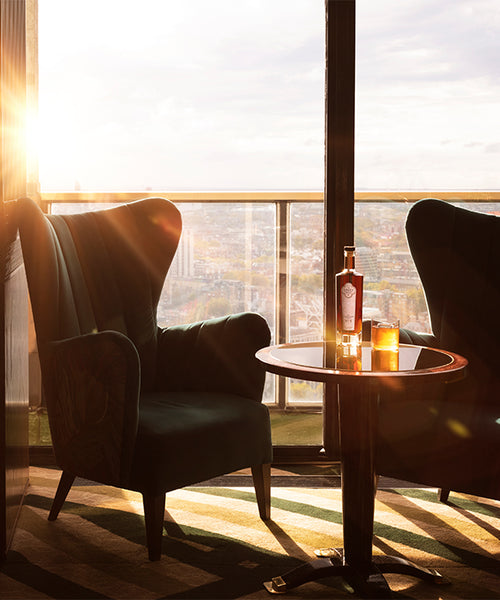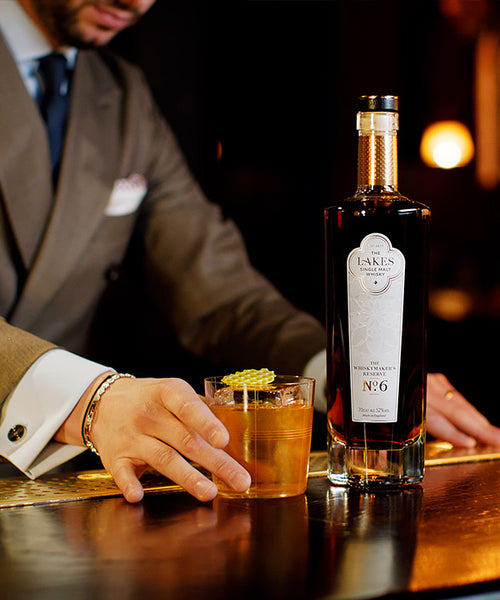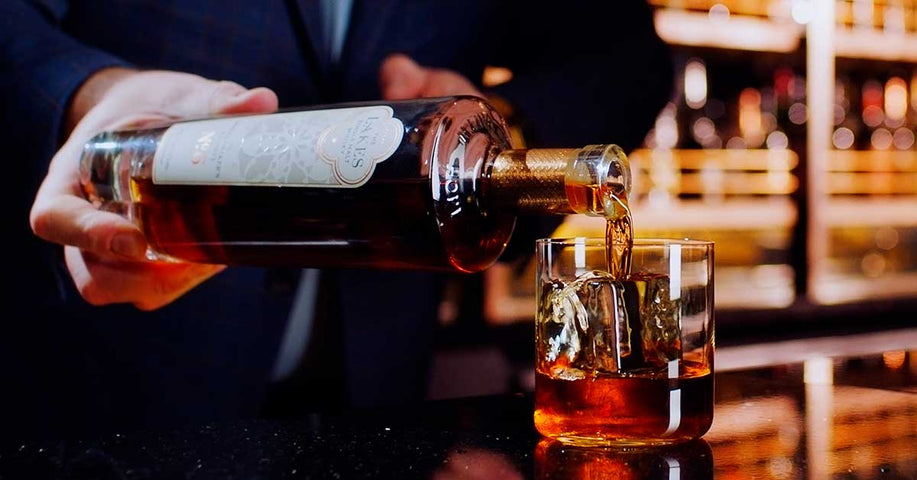As one of the world’s oldest and most recognised serves on record, the Old Fashioned needs no introduction.
A pioneer, an icon, and revered worldwide, you will find this classic serve heading cocktail lists in bars and venues across every continent. With a life spanning over 200 years, the respect garnered by the Old Fashioned has remained consistent over time.
Following the classic cocktail formula; spirit, sugar, water, and bitters, created back in 1806, the Old Fashioned is by definition - the original cocktail.
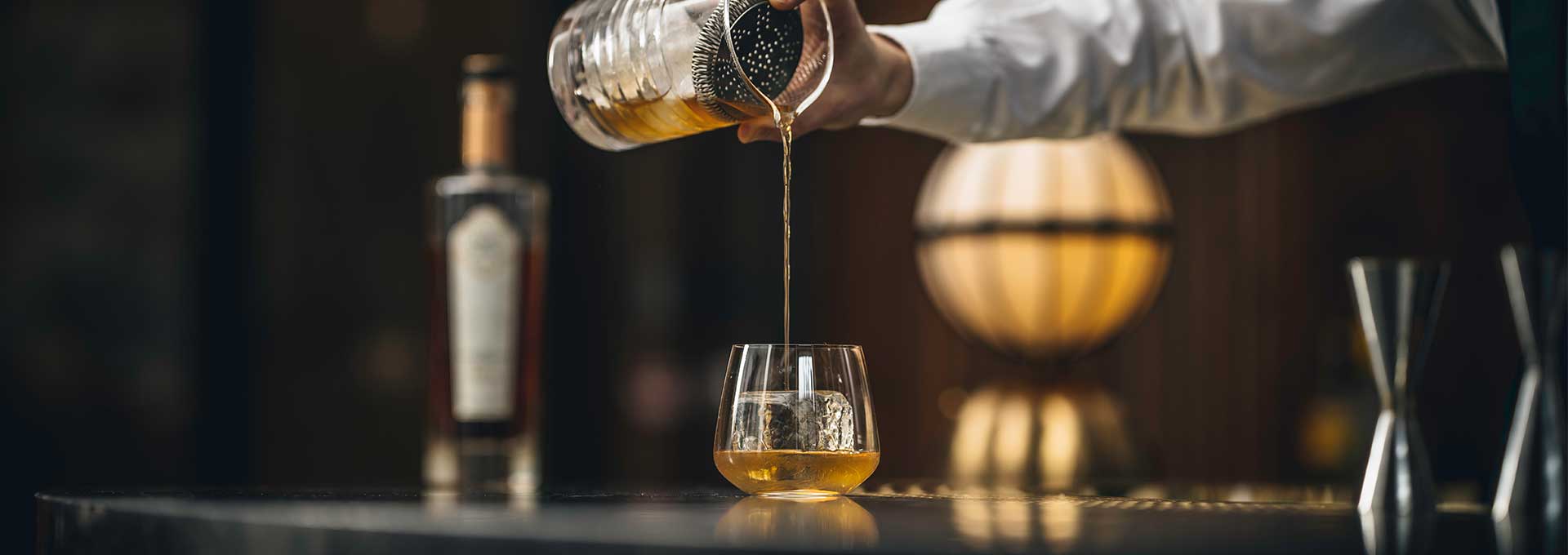
What is an Old Fashioned?
THE WHISKY
Traditionalists call for rye or bourbon whiskey to be used, as these would’ve been the whiskies used in the cocktail’s formative years. If you are looking at the traditional approach, it’s important to know their contrasting flavour profiles and how it will affect the taste of the cocktail. Rye is sharper and spicier whilst bourbon provides a sweeter flavour. At The Lakes, we believe you should enjoy as you please, so if it’s a fine blended or single malt whisky you would prefer, that is acceptable too.
SUGAR
Early Old Fashioned recipes insist on the use of sugar cubes. So, if you intend on making your version as traditional as possible, we recommend using brown demerara sugar cubes. Many agree brown sugar provides more depth with its sweet caramel flavour, and with cubes already being measured, you can achieve the perfect ratios to whisky and bitters. But prepare for more work - you’ll need to stir for longer (more on that later) until it dissolves. A common alternative to cubes is sugar syrup, which can be brought pre-made or easily prepared at home – remembering the golden ratio - 2 parts sugar to 1 part water.
BITTERS
Angostura bitters are the default choice for many mixologists. There are lots more craft bitters out there to experiment with, but we recommend sticking to this formula to begin with. A necessary component for making a good Old Fashioned, its infusion comprising of aromatics and botanicals help tie all the cocktail’s flavours together. With such bold and bitter ingredients, only 2-3 drops are needed to help an Old Fashioned achieve its depth and complexity. Try to avoid adding any more than this as the bitters will likely overpower the flavour of the whisky.
ICE
The purpose of ice in cocktails goes beyond keeping the drink cool, which is even more evident in the Old Fashioned. Playing a significant role in the drink’s flavour, whilst being stirred, the ice breaks down and adds water, also known as dilution. This process mellows the alcohol and marries the flavours, creating a smooth, sweet taste for the imbiber. You will often see bartenders opting for a singular large ice-cube mould to help slow down the melting process and remove the danger of overdiluting the drink. We suggest using large ice cubes (the bigger, the better) and filling your Old Fashioned glass with two-thirds ice.
THE STIR
Contrary to James Bond’s favourite cocktail, the Old Fashioned is to be stirred and never shaken. One of the most iconic traits associated with this drink, stirring is a time consuming, yet fundamental stage, when making this drink. This process helps create the smooth texture of the drink with the aid of dilution, as well as helping to fully dissolve the sugar. For the best results; use a bar spoon, stir the ingredients with ice for a maximum of 30 seconds before straining the mix over a glass with fresh ice cubes.
GARNISH
No traditional Old Fashioned is complete without the addition of an orange peel. This adds a citrus flavour to the cocktail without over sweetening it. By twisting a piece of the rind for the garnish– also known as ‘expressing the peel’- the citrus oils float on top of the drink. To do this, simply place a sharp knife between the rind and flesh and carefully separate them. Cut the rind into strips and gently roll the strip of peel into a spiral. When adding the twist to your drink, slowly rim the edge of the glass with the outside of the orange twist to capture the fruity oils in the rind, and then drop the twist into the cocktail.
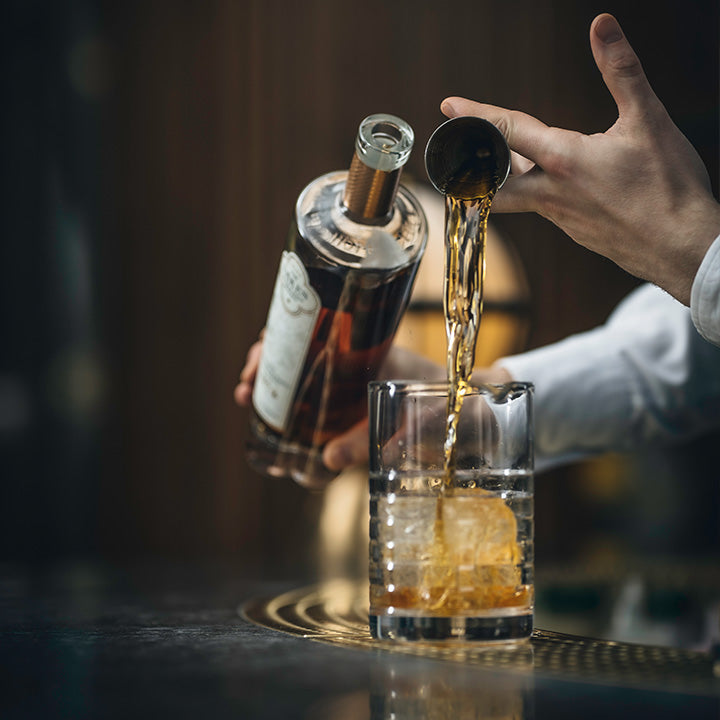
Tasting notes
What does an Old Fashioned taste like?
A drink that showcases the complex flavours of whisky, the Old Fashioned is doted by imbibers who enjoy a spirit-forward cocktail.
With whisky playing a central role, the taste of the drink is dependent on the type of spirit used. From bourbon and rye whisk(e)y to blended and single malts, there are a wide variety of whiskies out there which can be used in this classic serve – each one presenting its own unique flavour profile.
Whilst whisky is the focal point, the influence of the other pillar ingredients - sugars and bitters – have on the makeup of the drink can’t be overstated. Enhanced layers of flavour are created from the sweetness of the sugar syrup and the herbal, sharp undertones from the bitters, resulting in a soft balance that complements the spirit.
Our twist on an Old Fashioned: Winam
How to make an Old Fashioned
Our take on the Old Fashioned takes on a red wine infuence, where the warm spices and sweet berry flavour notes of the The Whiskymaker's Reserve are enhanced by contrasting flavours of the sour cherry juice and rich date syrup in our signature cocktail, Winam.
- Begin by adding plenty of ice to a rocks glass.
- Mix the whisky, sour cherry juice and date syrup in a cocktail shaker.
- Stir until fully dissolved.
- Add ice and continue to stir.
- Pour into a rocks glass with a large ice cube.
- Garnish with a squeeze of orange peel and a piece of candied ginger.
| 50ml | The Whiskymaker's Reserve |
| 15ml | Sour cherry juice |
| 1tbsp | Date syrup |
| Garnish | Orange peel & candied ginger |
The history of the Old Fashioned
An iconic status in the world of cocktails typically entails origins shrouded in dispute and mystery - The Old Fashioned is no exception.
Various people and bars across many places have declared their ownership of the original Old Fashioned. The most persistent claim comes from a private social club in Louisville, Kentucky. Founded in 1881, The Pendennis Club is where bartender James E. Pepper is said to have invented the inaugural Old Fashioned before taking his creation to the Waldorf-Astoria hotel bar in New York City. However, just like its fellow claimants, this story has been debunked and we must go back several decades previous for more validity.
The drink’s initiation coincides with the early stages of the cocktail era at the beginning of the 19th century. Following the classic cocktail formula, defined in The Balance and Columbian Repository in 1806, as “a stimulating liquor, composed of spirits of any kind, sugar, water, and bitters”, it is a cocktail in its purest form. Originally called the “Whiskey Cocktail”, it was served without ice and ‘knocked back’ in the morning for an ‘eye-opener’ before transitioning into a sipping drink amongst a younger, more prosperous crowd in the 1840s.
Following the end of Prohibition in 1933, the Old Fashioned underwent a significant revision. Bartenders opted for adding orange slices or maraschino cherries to the recipe, which many believe was to mask the poor-quality taste of the liquid at the time. This led to many decades of fruit-infused versions of the drink being consumed throughout the 20th century.
The start of this century saw a shift back to its roots, with mixologists choosing to abide by the original recipe and serve without mashed up fruit. Whilst new variations of this classic continue to be created, it is more widely accepted that the traditional formula is the best way to enjoy this classic cocktail.
Did you know?
The existence of the Old Fashioned came under threat during the prohibition years, with a gin variation of the drink - The Old Fashioned Holland Gin Cocktail - being mentioned in Jerry Thomas’ Bartender Guide: How to Mix Drinks. With gin being simpler, cheaper and faster to produce than whisky, this also saw the rise in growth of gin-based cocktails.
The rise and rise of the Old Fashioned
Since capturing the hearts of imbibers over two centuries ago, the Old Fashioned continues to enjoy a lofty place at the top of cocktail lists worldwide.
Putting the Prohibition era aside, where whisky was less accessible, the demand for this quintessential drink has remained constant. Popular amongst both mixologists and imbibers, the beauty in this drink is its simplicity. As of 2022, Drinks International Magazine ranks the Old Fashioned Cocktail as the second best-selling classic cocktail in the world. It is clear to see this classic cocktail has stood the test of time.
And whilst the Old Fashioned has never really been away, it enjoyed a surge in popularity in the 2010s thanks to a fictional TV character, where cool and charming protagonist, Don Draper, in Mad Men was seen regularly sipping one throughout seven series of the 1960s-based American drama. Just like James Bond did for the Martini, the Old Fashioned was a beneficiary of pop culture’s influence.
As imbibers continue to discover serves made with high quality spirits both in bars and at home, this humble concoction epitomises the age-old mantra of “less is more.”
Reimaging the Old Fashioned
Bartenders from bars across the globe continue to find new ways to add a new perspective on the Old Fashioned cocktail.
By adding a twist to the traditional, layering complementary and contrasting flavours, and integrating personal influences within the recipe, we sought some of the finest mixology minds to help develop their own delectably delicious takes on this whisky cocktail.
The result was a series of sophisticated and dramatically different serves, each one with The Whiskymaker’s Reserve at their heart.




























